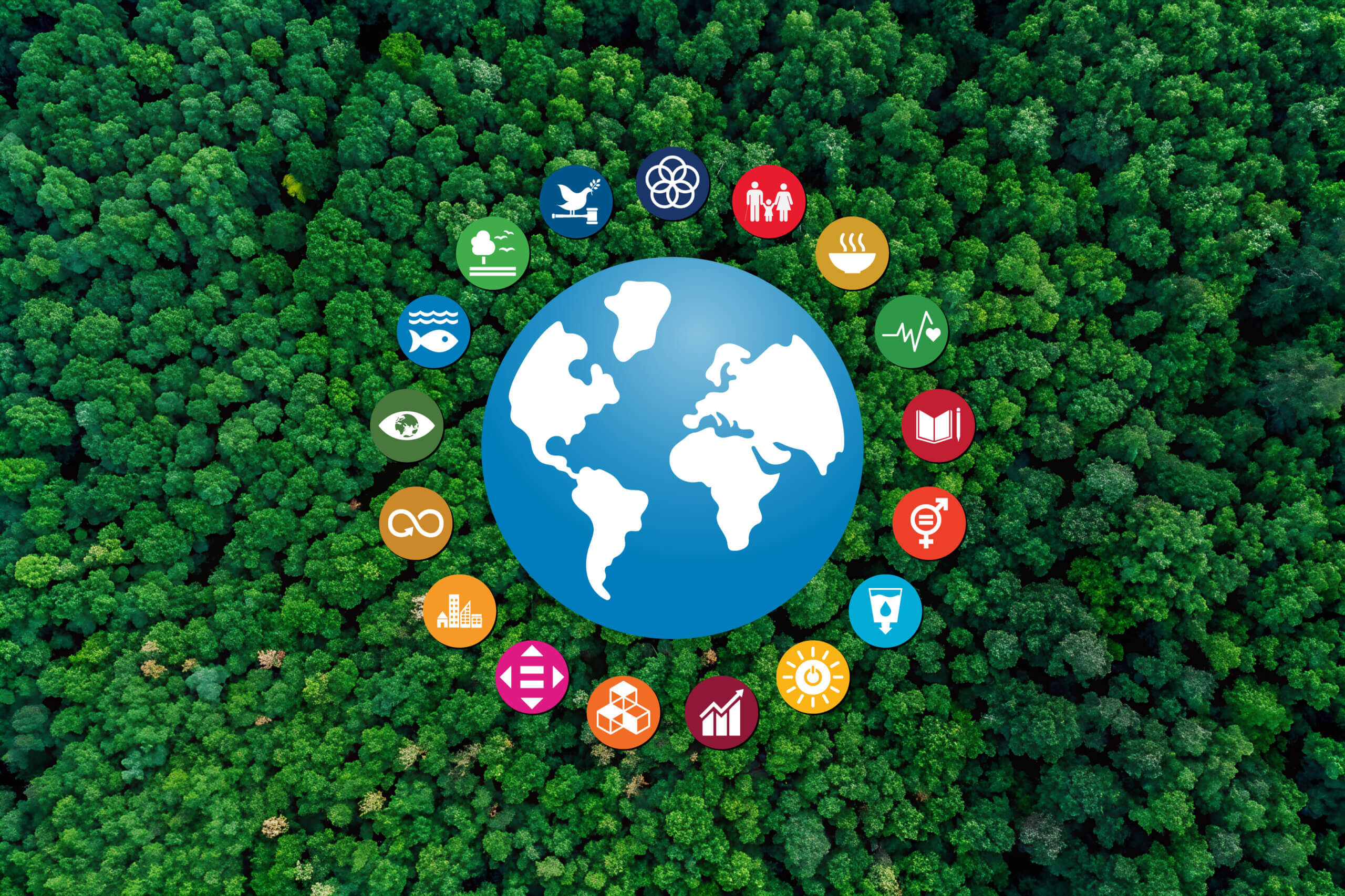The Sustainable Development Goals (SDGs) represent a collective global effort to address pressing issues such as poverty, inequality, and climate change. These 17 goals, established by the United Nations in 2015, are interconnected and offer a comprehensive framework for creating a more sustainable future. Supporting UN SDGs are often an important goal of leading corporate sustainability departments and sustainably minded individuals. are an essential mechanism for achieving these SDGs, particularly in combating climate change and fostering sustainability. This blog delves into the importance of carbon offset projects in helping meet global sustainability targets and explores the critical role they play in advancing the SDGs.
Understanding the Sustainable Development Goals (SDGs)
The SDGs are a universal call to action to eliminate poverty, protect the planet, and ensure prosperity for all by 2030. Adopted by all United Nations Member States, the SDGs are designed to address a wide range of global challenges. Each of the 17 goals focuses on specific issues such as environmental sustainability, social inclusion, and economic growth. Here’s a quick overview of the 17 goals:
- No Poverty
- Zero Hunger
- Good Health and Well-being
- Quality Education
- Gender Equality
- Clean Water and Sanitation
- Affordable and Clean Energy
- Decent Work and Economic Growth
- Industry, Innovation, and Infrastructure
- Reduced Inequality
- Sustainable Cities and Communities
- Responsible Consumption and Production
- Climate Action
- Life Below Water
- Life on Land
- Peace and Justice Strong Institutions
- Partnerships for the Goals
The SDGs are interconnected, and one of the primary goals, SDG 13: Climate Action, is where carbon offset projects make a direct impact. These projects are vital for achieving climate-related targets and tackling the environmental crisis.
What Are Carbon Offset Projects?
Carbon offset projects aim to reduce greenhouse gases (GHGs) in the atmosphere by investing in initiatives that either prevent new carbon emissions or remove existing carbon emissions. These projects are essential for counteracting the adverse effects of human activities, which contribute to global carbon emissions.
Examples of carbon offset projects include:
- Reforestation and afforestation: Planting trees or restoring forests to absorb CO2.
- Renewable energy: Investing in solar, wind, and hydroelectric energy to replace fossil fuel-based power.
- Energy efficiency: Implementing energy-saving measures in industries, buildings, and transportation.
- Methane capture: Collecting methane from landfills, farms, or wastewater treatment facilities to prevent its release into the atmosphere.
Carbon offset projects are verified by recognized standards such as Verra and the Gold Standard, which ensure that these initiatives lead to real and permanent environmental benefits.
The Interconnection Between SDGs and Carbon Offset Projects
Carbon offset projects play a crucial role in helping achieve multiple SDGs, particularly those focused on climate action, clean energy, and sustainability. Here’s how carbon offset projects contribute to some of the most important SDGs:
- SDG 13: Climate Action
The direct link between carbon offset projects and SDG 13: Climate Action cannot be overstated. Climate change is one of the most urgent threats facing the planet, and carbon offset projects are a critical tool in the global fight to limit global warming to well below 2°C, as set out in the Paris Agreement. According to the United Nations Framework Convention on Climate Change (UNFCCC), carbon offset projects that reduce emissions or capture CO2 help countries meet their national climate targets and contribute to global efforts to combat climate change.
For example, projects such as reforestation and renewable energy help reduce the amount of CO2 in the atmosphere, preventing the harmful consequences of rising temperatures. The International Energy Agency (IEA) reports that carbon offset projects in clean energy could reduce up to 5.3 gigatonnes of CO2 by 2030.
- SDG 7: Affordable and Clean Energy
SDG 7: Affordable and Clean Energy advocates for the transition to renewable energy sources and aims to ensure universal access to affordable, reliable, and modern energy. Carbon offset projects that focus on renewable energy — such as wind, solar, and hydroelectric power — contribute directly to this goal by replacing fossil fuels with cleaner alternatives. The reports that renewable energy could account for 70% of the global power generation by 2050, significantly reducing global emissions.
Carbon credit sales provide critical climate finance to renewable energy projects, particularly in regions that have limited access to energy, contributing to energy equity and access in underserved areas.
- SDG 15: Life on Land
SDG 15: Life on Land aims to protect, restore, and promote the sustainable use of terrestrial ecosystems. Carbon offset projects that focus on reforestation and afforestation are critical to achieving this goal. According to the Food and Agriculture Organization (FAO), forests are responsible for absorbing approximately 30% of global CO2 emissions, making forest restoration a key method for offsetting emissions.
These projects not only reduce atmospheric CO2 but also restore habitats, protect biodiversity, and combat desertification. For instance, large-scale reforestation efforts, such as Restauración Forestal in Mexico’s Yucatán Peninsula, play a crucial role in stabilizing ecosystems, enhancing biodiversity, and supporting the livelihoods of local communities.
- SDG 12: Responsible Consumption and Production
SDG 12: Responsible Consumption and Production encourages industries, governments, and individuals to adopt sustainable practices that minimize resource use and reduce waste. Carbon offset projects that focus on energy efficiency, waste management, and sustainable agriculture support this goal by promoting better resource management and reducing overall environmental impact.
These projects help industries lower their carbon footprints and implement sustainable practices, encouraging a shift toward circular economy models where waste is minimized, and resources are reused.
- SDG 8: Decent Work and Economic Growth
SDG 8: Decent Work and Economic Growth focuses on promoting inclusive and sustainable economic growth. Carbon offset projects can drive job creation and economic development, particularly in developing regions. For example, renewable energy projects such as solar and wind farms create jobs in construction, maintenance, and operation.
The World Bank reports that renewable energy projects have the potential to create over 85 million jobs by 2030. By investing in these initiatives, countries can stimulate local economies, reduce unemployment, and promote sustainable development.
Terrapass: Supporting Carbon Reduction Projects with SDG Impact
As a leader in the field of carbon offsetting, Terrapass supports a range of carbon reduction projects that align with the SDGs, ensuring that the environmental, social, and economic benefits of these projects are maximized.
Terrapass partners with verified projects across the globe that have tangible impacts on climate change and also promote additional SDGs such as clean energy access, economic growth, and ecosystem restoration. Terrapass carbon credit sales provide critical funding for renewable energy, forest conservation, and methane capture projects that contribute to SDGs like SDG 7 (Affordable and Clean Energy), SDG 13 (Climate Action), and SDG 15 (Life on Land).
By funding these types of projects, Terrapass is not only helping organizations and individuals offset their carbon emissions but also driving broader sustainability goals that impact communities and ecosystems worldwide. This approach ensures that the carbon offset initiatives supported by Terrapass contribute meaningfully to the achievement of multiple SDGs, fostering long-term positive change on a global scale.
The Importance of Carbon Offset Projects for Achieving the SDGs
Carbon offset projects and carbon removals are a practical solution for addressing some of the world’s most pressing environmental challenges. These projects help balance the carbon emissions produced by human activities, allowing businesses and individuals to take responsibility for their environmental impact. But the benefits of these projects go beyond just reducing carbon emissions; they also support other critical SDGs by promoting clean energy, fostering economic growth, and protecting ecosystems.
The UN’s Intergovernmental Panel on Climate Change (IPCC) estimates that to avoid catastrophic climate impacts, we must reduce global emissions by 45% by 2030. Carbon offset projects offer a way to make significant progress toward this goal, making them an essential tool in the global effort to combat climate change.
Carbon offset projects and carbon removals are not only key to mitigating climate change but are also integral to achieving the Sustainable Development Goals. From promoting clean energy and job creation to restoring ecosystems and reducing emissions, these projects support multiple interconnected global goals. Whether you’re a business, government, or individual, investing in carbon offset projects is a tangible way to contribute to a sustainable future. With global emissions on the rise, the urgency to implement carbon offset solutions is greater than ever. By acting now, we can ensure a cleaner, more equitable world for future generations.
Terrapass helps businesses take meaningful climate action by offering carbon removals and carbon offsetting solutions. Our sustainability advisors are ready to guide you in selecting the best carbon removals and offset solutions tailored to your needs. Contact a Terrapass expert today to explore your options and make a positive environmental impact.
Sources:
- United Nations, Sustainable Development Goals, SDG 1, SDG 2, SDG 3, SDG 4, SDG 5, SDG 6, SDG 7, SDG 8, SDG 9, SDG 10, SDG 11, SDG 12, SDG 13, SDG 14, SDG 15, SDG 16, SDG 17: https://sdgs.un.org/goals
- UNFCCC, Climate Action: https://unfccc.int
- International Energy Agency (IEA), Renewables and Energy Efficiency: https://www.iea.org
- Food and Agriculture Organization (FAO), Forests and Climate Change: http://www.fao.org
- International Renewable Energy Agency (IRENA), Renewable Energy for All: https://www.irena.org
- UN’s Intergovernmental Panel on Climate Change (IPCC): The evidence is clear: the time for action is now. We can halve emissions by 2030. — IPCC
- World Bank, Renewable Energy Jobs: https://www.worldbank.org
- United Nations Framework Convention on Climate Change (UNFCCC): What is the United Nations Framework Convention on Climate Change? | UNFCCC
- Terrapass, Carbon Offset Projects, Terrapass Standards, Solutions for medium-large businesses: https://www.terrapass.com






